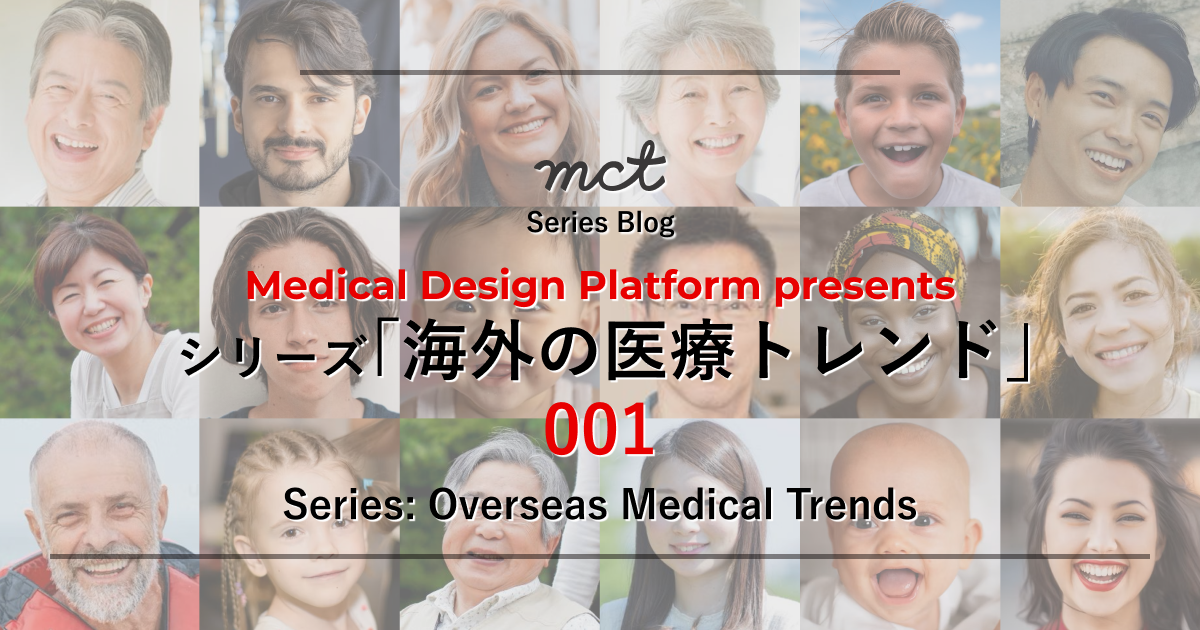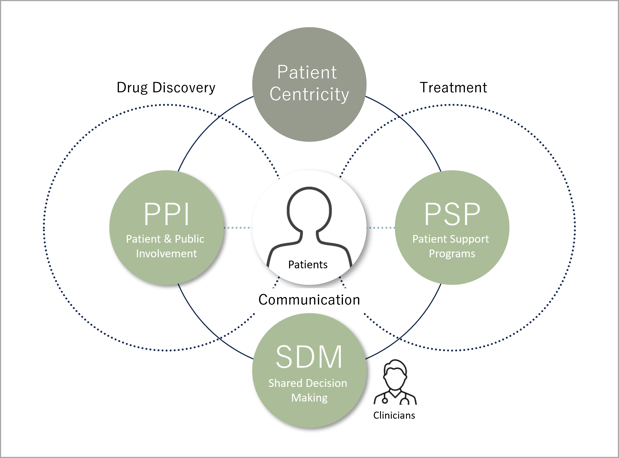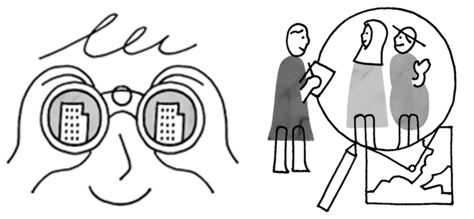2024.07.22
Series Blog|シリーズ 「海外の医療トレンド」 001 Overseas Medical Trends

brought to you by mct's "Medical Design Platform".
株式会社mctの「患者さん中心の医療」に関わる情報やサービスを提供するユニットです。
It is a unit that provides information and services related to "patient-centered medicine" of mct, Inc.
PPI, SDM, PSP… How does this all fit into ‘Patient Centricity’?
そして患者中心という考え方の核心は、ヘルスケア関連製品やサービスの開発・提供において、患者さんをより意図的に優先させるための、メディカル分野における取り組みであると言えます。この取り組みの中でカギとなる変化は、パターナリズム(父権主義)的なトップダウンの関わり方から、継続的で協働的なパートナーシップへの移行です。
In the healthcare space globally, the idea of “patient centricity” has been firmly established for some time now – to the point where it may be assumed that there is a single consensus idea of what it means and that everyone is aware of it.
And yet, there are debates about what being patient centric should mean – is it about engagement? outcomes? And what the effective and ethical ways to go about it are.
At its core, we can say that it is an effort in the healthcare space to be more intentional about prioritizing patients in the development and delivery of healthcare related products and services. Within this effort, a key change is the transition from paternalistic, top-down engagement to ongoing collaborative partnerships.

◆患者中心のさまざまな側面:PPI、SDM、PSP
まずはひとつめのアプローチ。前臨床試験の調査段階では、「Patient and Public Involvement(患者・市民参加)」の略である「PPI」というのがあります。開発プロセスの早い段階で、患者さんや一般のステークホルダーに参加いただき、患者さんの状況をより深く理解し、今後のバリュープロポジションを明確にすることを目的としています。PPIの例としては、患者さんとの1対1のインタビューやコ・クリエーションセッションなどがあります。
次に、臨床試験段階が終わり、ローンチ時期が近づくと、「Shared Decision Making(意思決定の共有)」の略である「SDM」にアプローチを転換します。米国国立衛生研究所によれば、SDMとは「医療者と患者が医療に関する共同決定に至るために、最善の医学的エビデンスを共有し、選択肢を検討し、患者が個人特有の選好をできるようにするアプローチ」です。医療分野の企業にとって重要なのは、どのような情報やエビデンスであれば、患者さんや患者さんの周りのステークホルダーに、医療従事者と双方向の信頼関係があると感じてもらえるかを配慮することです。
そして、3つ目に「Patient Support Program(患者支援プログラム)」の略である「PSP」というアプローチがあります。PSPは、診断や治療方針の決定後、その決定に遵守することで最善のアウトカムが得られるよう、患者さんを支援するものです。しかしそのためにPSPは、患者さんに共感され、患者さんの実生活や意欲に沿ったものであり、かつ診断や治療による実際的な障害の解決を試みるものでなければなりません。
There are three kinds approaches within patient centricity we would like to introduce, each being relevant to a different stage of creating better outcomes for patients.
During the pre-clinical trial research phase, we can think about PPI, which stands for “Patient and Public Involvement”. The aim is to engage patients and public stakeholders early in the development process to understand the patient situation more deeply and clarify potential value propositions. Some examples of PPI activities would be with one-on-one interviews with patients or co-creation sessions.
After clinical trials phase and around launch timing, we can shift our thinking to SDM, or “Shared Decision Making”. According to the National Institute of Health, SDM is an “an approach where clinicians and patients share the best available evidence when faced with the task of making decisions, and where patients are supported to consider options, to achieve informed preferences”. The key for businesses in the healthcare space is to think about what kind of information and evidence will help patients and patient stakeholders feel that there is a mutual trust in the relationship with healthcare providers.
Then there are obviously “Patient Support Programs”, or PSPs. PSPs are about helping patients following a diagnosis or treatment decisions in order to ensure the best possible outcomes from adherence to those decisions. But to do so, PSPs need to resonate with patients and align with their real life, their real motivations, and seek to address their real obstacles from diagnosis and treatment.

◆医療が複雑化する中、社会は進化している
Society is Evolving as Healthcare Becomes Increasingly Complex
こうした流れは、医療分野に限らず、私たちの日常生活のあらゆる部分に影響を及ぼしています。また、このように意識とケイパビリティが高まった結果、関係するさまざまな制度やステークホルダーの複雑さも増しています。新しい治療を開発し、アウトカムを患者さんに提供する際、この複雑性をトップダウンやB2Cのやり方で管理することは、効果的でも効率的でもありません。さまざまなステークホルダーと価値をコ・クリエーションする協働関係としてアプローチを捉え直すことによって、メディカル分野におけるさまざまなサービス提供者は、多様な段階で患者さんや患者さんの周りのステークホルダーをどのように巻き込んでいくか見出さなければなりません。患者中心の重要性を確認するのは、価値をコ・クリエーションするという目標に向けた基本的な第一歩です。
What are the forces driving the need for a more patient centric approach? Foremost, we can see the availability of information as a key reason. With more information available to more people, increased sense of awareness leads to increased empowerment and expectations. For example, we can see this in the progress around DEI initiatives and precision medicine.
This is a force that has affected all parts of our daily life, not just in the healthcare space. As a result of this greater awareness and capability, there is also an increased complexity of the different systems and stakeholders involved. When it comes to developing and delivering healthcare outcomes to patients, managing this complexity in a top-down, or B2C way is not effective or efficient. By reframing the approach as a collaborative relationship between different stakeholders co-creating value, providers in the healthcare space need to find ways to involve patients and patient stakeholders in various phases. Affirming the importance of patient centricity is a fundamental step towards that goal of co-creating value.
◆患者中心の取り組みは、グローバルかつ成熟している
Patient Centricity Activities are Global and Maturing
患者中心を具体的な行動の方向性として捉えると、世界中のさまざまなプレーヤーが、患者さんとの関係のあらゆる時点で、いろいろな方法で追求していることがわかります。しかしながらPPI、SDM、PSPなどの取り組みに、万能な方法はありません。そして、患者中心という考え方は少し前から存在はしていましたが、実際には、最も効果的な事例から学び、新しい技術や競争に適応しながら、成長し続けているのです。
その取り組みの範囲はグローバルにわたりますが、大半は欧州と米国から発信されているようです。このシリーズブログは、これらの地域で収集した興味深いケーススタディや新たなトレンドに焦点を当てて紹介します。重要なのは、プレーヤーがPPIやPSPをどのように適用しているかだけでなく、そのような投資がビジネスにどのようなインパクトをもたらすかを見ることでもあります。ぜひご期待ください。
Seeing patient centricity as a direction for specific actions, we can see that different players around the world are pursuing patient centricity in different ways at different points in the patient relationship. There is no one-size fits all application of patient centricity, or even activities within specific areas such as PPI, SDM, and PSP. And while patient centricity has been around for a while, what it looks like practically continues to evolve, learning from what is most effective and adapting to new technologies and competition.
While activity is global in scope, it does appear that the majority of activity is coming out of Europe and the United States – which is where we will focus on collecting interesting case studies and emerging trends to present in this blog series. The key is also to look at not just how players are applying PPI or PSP, but also at the business impact such investment leads to.
This blog is the first in a series that we are launching this year to focus on overseas activities related to patient centricity topics. We hope to curate a well-rounded picture of what is going on, and to clarify overall directions and specific learnings for Japanese companies in this space. Please stay tuned.

ーーーーーーーーーーーーーーーーーーーーーーーーーーーーーーーーーーーーーーーーーーーーーーーーーー
mct はクライアントがステークホルダーを深く理解するためのお手伝いをしています。
mct Helps Clients to Deeply Understand Stakeholders
mctは2002年以来、人間中心のデザインリサーチでクライアントをサポートしており、特にメディカル分野のクライアントと強力な関係を築き、患者中心のインサイトを獲得してきました。私たちは、患者さんの視点を理解し、企業が患者さんにより共感できるようにし、製品やサービスの開発に患者さんのインサイトを取り入れるためのクライアントの取り組みを促進することに長期的にコミットしています。
患者中心という目標は、さまざまなステークホルダーや基礎となる制度を考慮しながら、進化と拡大を続けています。同様にmctは、患者調査、患者中心への取り組み、患者プログラムの改良、新規事業の設計などをサポートし、クライアントのニーズに応えるため、状況の変化に合わせて進化し続けていきます。
mct has been supporting clients with human-centered design research since 2002, with a particularly robust history with clients in the healthcare space and gaining patient-centered insights. We have a long term commitment to understanding patient perspectives and facilitating clients’ efforts to increase organizational empathy with patients and include patient insights into development of products and services.
As patient centricity itself expands and evolves, going beyond just the patient to consider various stakeholders and underlying systems, mct continues to adapt to the changing situation to meet our clients’ needs – supporting patient research, patient-centricity initiatives, refining patient programs, designing new businesses, and more. 
ーーーーーーーーーーーーーーーーーーーーーーーーーーーーーーーーーーーーーーーーーーーーーーーーーー
英語原文作成:Eric Frey 日本語版編集:程野耕治
-

-
Eric Frey
株式会社mct エクスペリエンスデザイナー
- CX・顧客経験
- 組織デザイン
- インサイト
- グローバル
- 顧客中心
- ヘルスケア
- 患者理解
- 製薬
- サスティナビリティ
- 患者中心
- PPI
- PSP
- SDM
- ビジネスデザイン
- ペイシェント・セントリシティ
- イベント告知
- イノベーション
- デザイン思考
- 働き方
- DMN
- コ・クリエーション
- チームワーク
- セミナー
- 働き方改革
- ZMET
- エクスペリエンスデザイン
- futuredesign
- covid19
- エスノグラフィックリサーチ
- デザイン
- デザインリサーチ
- リモートコラボレーション
- ワークショップ
- 事業開発
- ソリューション
- CXマネジメント
- カスタマージャーニー
- オンラインワークショップ
- ギャップファインディング
- 従業員体験
- signal
- ブランディング
- 技術開発
- 101_design_methods
- フューチャーデザイン
- エンゲージメントデザイン
- サービスデザイン
- トレーニング
- メソッド
- シグナル
- 機会探索
- PlayfulNetwork
- マインドセット
- AI
- COM-B
- SDGs
- UIデザイン
- サーキュラーエコノミー
- フューチャー思考
- CSA Research
- UXデザイン
- mcTV
- プレイフル
- 事例
- 製品・サービス開発
- Forrester research
- フィールドワーク
- メタファー
- リフレーム
- Employeeexperience
- エフェクチュエーション
- カルチャーコード
- クルースキャン
- シグナル探索
- ビジネスデザインプログラム
- フレームワーク
- プロトタイピング
- CX4DX
- CultureMeetup
- PRO
- gamefulCX
- leadership
- mct labo
- お知らせ
- ゲームデザイン
- デザインスプリント
- トレンドリサーチ
- ビジネスモデル
- 映像編集
- MOT
- NELIS
- Remo
- インタラクションマップ
- デジタルエクスペリエンス
- デジタルツール
- バイアス
- ファシリテーション
- プロダクトジャーニー
- 学習
- LGBT
- wasedaneo
- インタビュー
- インプロ
- セルフドキュメンタリー
- デザインシステム
- デザイントレンド
- デザインマネジメント
- デジタル
- ベンチマークリサーチ
- リーダーシップ
- リーンスタートアップ
- ロードマップ
- 伴走型支援
- 創造性開発
- 動的安定性
- 反脆弱性
- 学習体験デザイン
- 市場調査
- 測定
- 用途開発
- 研修
- 経営戦略
- 調査設計
- 資本提携


